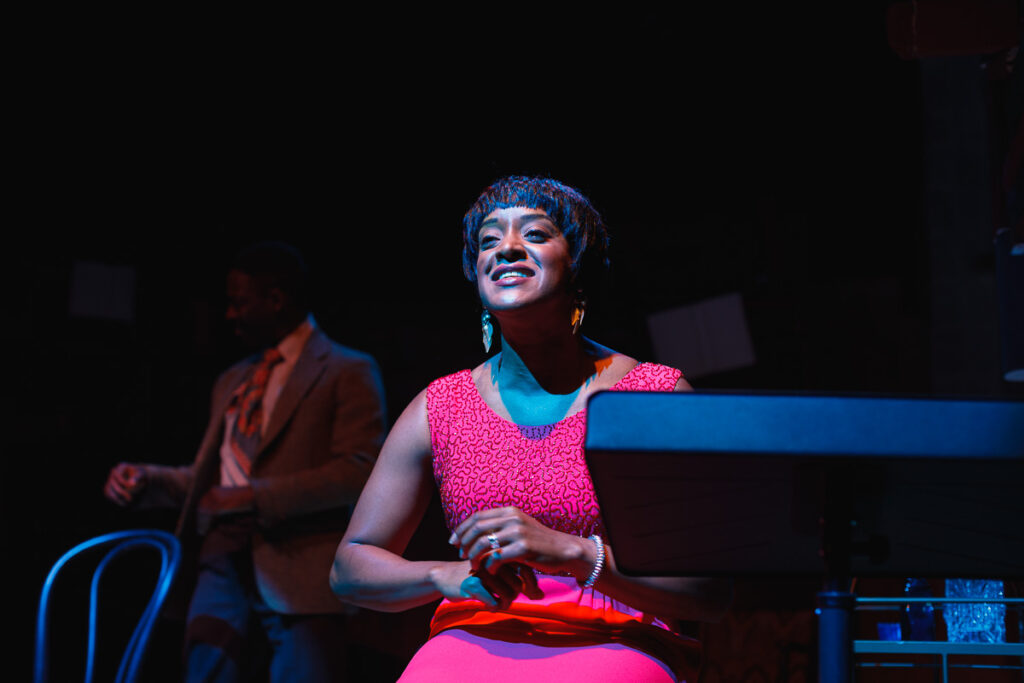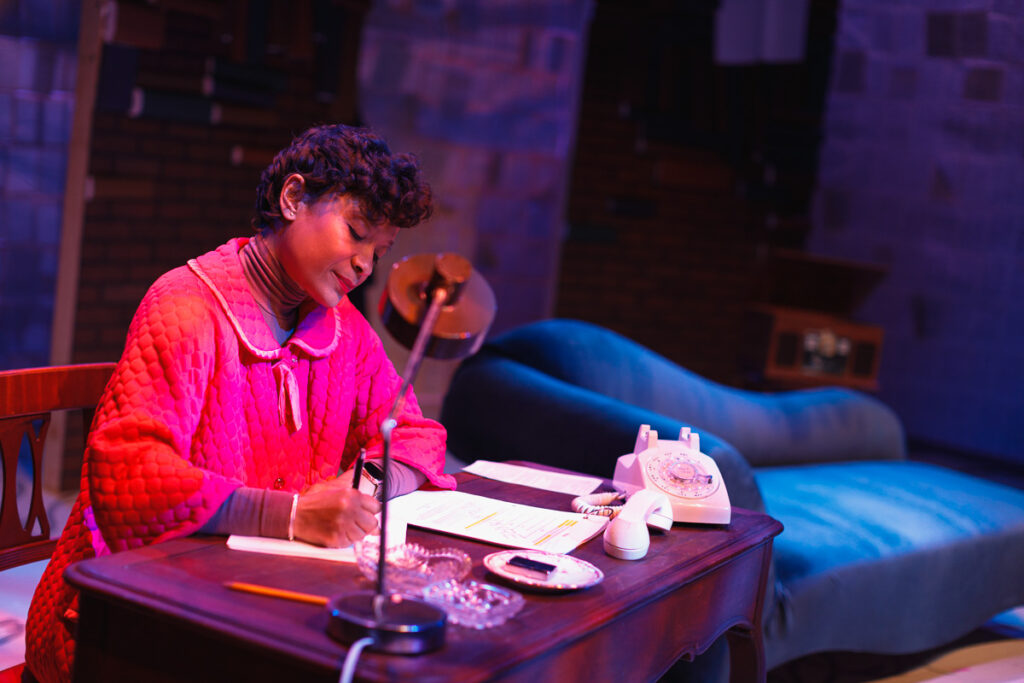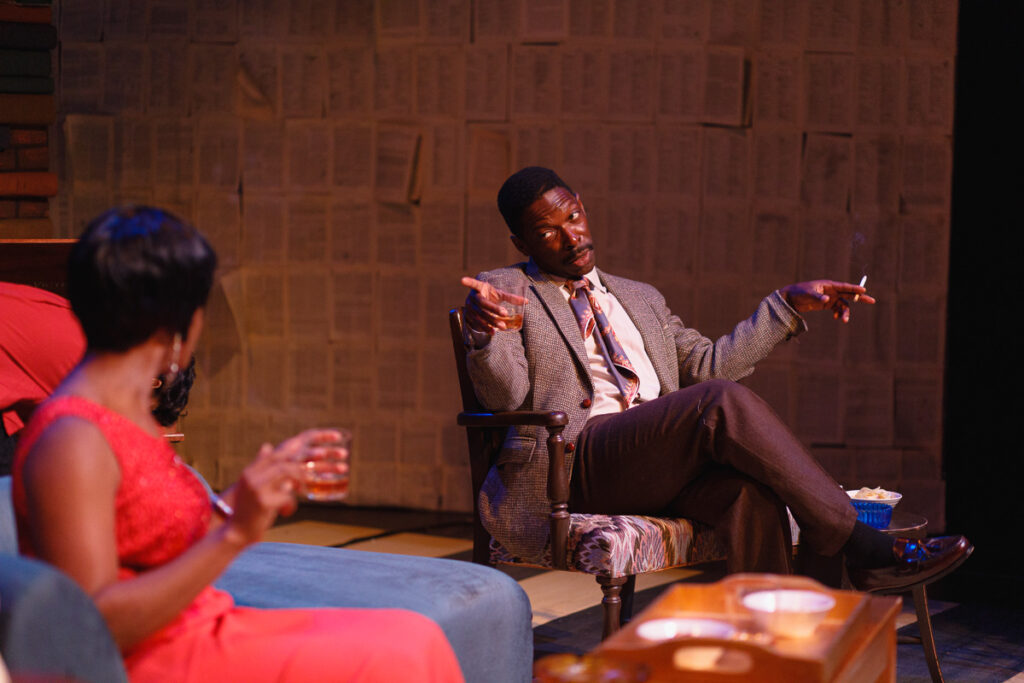I’ll admit the very premise of Traci Tolmaire’s In the Evening by the Moonlight (world premiere through July 2 at Fort Mason Center, SF) was one designed to hook me in. I’m a sucker for stories about famous artists hanging out: Dorothy Parker and The Algonquin Round Table; JRR Tolkien, CS Lewis, and The Inklings; even that odd group of Isaac Asimov, Robert Heinlein, and L. Ron Hubbard. What’s more, Tolmaire’s play is about that post-Harlem Renaissance generation that not only lived through lynch-happy 20th century, but who were involved in—and whose work was crucial to—the Civil Rights Era. (I did developmental readings for a similar play by Jewelle Gomez.)
But what works best in Tolmaire’s favor is that she’s wise enough to include the two factors often left out of portrayals of artists: casual joy and casual rage. I emphasize casual because when an artist portrays the life of another artist, the former often falls into the trap of purple prose. Dramatists are so eager to make their own artistic stamp on the material that they often forget the beauty and importance that can come from the mundane. Tolmaire not only considers this, but she knows that best way to portray three highly recognizable personalities is to not build them up, but show them at their most unguarded: drinking; smoking (a lot), and taking the piss out of one another, just as much as they’re clearly delighted to be in each other’s company.
The year is 1963, and authors Lorraine Hansberry (Tolmaire) and James Baldwin (Rotimi Agbabiaka)—fresh off a Baldwin-arranged meeting with Robert Kennedy—have come to see their good friend Nina Simone (Ryan Nicole Austin) work her musical magic in New York. After jamming through “Li’l Liza Jane,” Simone lashes out at one of the white “fake liberals” in the crowd who dared to shout out a request. Having now cleared the entire house, Simone warmly greets her two guests before the three retire to Hansberry’s apartment building in Waverly Place. There, the trio will spend the remainder of the evening sharing old memories and contemplating the changing world around them.

It’s a bit unfair to compare this Lorraine Hansberry Theatre show to Magic Theatre’s recent world premiere of Mark Anthony Thompson’s The Ni¿¿er Lovers, but one would be remiss not to, given their similarities: both are by companies that share residence and performance space; both revolve around how far (or not) Black people have come since slavery, how far we can go, and the white hypocrisy that ends up defining that evolution; and, of course, both feature the always-wonderful Rotimi Agbabiaka in lead roles.
Yet, where Thompson’s play seems to be tossing things at the wall to see what sticks, Tolmaire’s is focused in its scope (limiting the action to mostly one setting), still loose enough in its prose that the dialogue actually sounds like human speech. When our trio let loose about a topic—any topic (they bloviate about everything from religion to good scotch)—it’s done in such a way to make the audience feel as if we’re all decompressing in a friend’s home after everyone else from the party has gone home.
Nineteen sixty-three was a watershed year for both the trio and Black America: Baldwin has just published The Fire Next Time; Simone has just released her beloved Carnegie Hall album; and Hansberry is in the process of brainstorming what will become her play The Sign in Sidney Brustein’s Window.

Yet, the spectre of death hovers over the three like a storm cloud. The murder of their friend Medgar Evers brings the fear that one of them—particularly the openly gay Baldwin—could be next. There’s the fact that all three were or are in failing relationships that were once passionate, but died in their own ways. Finally, there’s Hansberry’s then-recent hospital stay, which she tries to play off, but she knows she’s been diagnosed with the cancer that will soon kill her. The script never specifies that fate, but the real-time fear it presents in the three makes the danger all the more palpable.
Talent and success notwithstanding, we’re shown three Black folks who are constantly reminded of their Blackness by the very white intelligentsia who claim they talk about race too much. Simone, a classically-trained pianist and vivacious singer, is resentful to be stuck under the “jazz” label just because it’s where Black folks are. Baldwin adores his adoptive home of France, but clearly misses the familiarity of New York that he finds in Hansberry’s building. Then there’s the biracial Hansberry, embracing Black Marxism almost as an apology for her wealthy upbringing under a white father.
Help us save local journalism!
Every tax-deductible donation helps us grow to cover the issues that mean the most to our community. Become a 48 Hills Hero and support the only daily progressive news source in the Bay Area.
It’s to the credit of both Tolmaire and director and LHT AD Margo Hall that a 95-minute chat-fest never once feels dull. Yet, even with plenty of bon mots to go around (such as Baldwin quipping that “The Kennedys are pretty, but they care little, virtually nothing, about The Negro Problem” and Simone resenting comparisons to “that new girl, Aretha”), there are points when Tolmaire lets Hansberry go on for so long that it feels like she wanted to give herself the best lines. Granted, they’re good lines, and the play ends on an ambiguous note hinting at a possible reason for our hearing Hansberry’s voice most prominently, but there’s still a noticeable favoritism for LHT’s namesake.

Speaking of which, Hall brings her usual nuanced touch for getting natural performances out of her great cast, but one wishes she’d have them explore Carlos Aceves’ set more (with its “books-and-mortar” design, decorated with Heidi Button’s props). The three spend most of the show in the gravitational pull of the center-stage sofa, occasionally hopping up to dance or sing. Though this is meant to be downtime for them, I wanted them to explore all of the page-lined walls of the set.
Though the performance I saw was the final preview, I was relieved to find that LHT, like their co-residents Magic Theatre, are keeping their mask policy in place, with Hall also pointing out the air filters flanking both sides of the stage. Being a preview, the house wasn’t full, but it still blew my mind to be at an indoor show where my Aranet4’s CO² readings peaked at 968ppm. Considering how quickly the theatre fills with the smoke from the actors’ herbal cigarettes, those are amazing numbers.
In the Evening… is definitely one of the better shows I’ve seen this year, bringing a wonderful down-to-Earth dimension to three icons of Black America and worldwide art. Though it clearly favors the woman from which the company takes its name, it gives all three characters a chance to shine, with a fine cast bringing them to life. There’s a point in which Hansberry criticizes MLK-nemesis William Faulkner and the privilege a white author like him gets for featuring Black characters: “White writers claim to write Black characters better than we can.” Fortunately, all Black folks (and others) who brought this play together understand the importance of letting us speak for ourselves.
IN THE EVENING BY THE MOONLIGHT’s world premiere runs through July 2 in the Young Performers Theatre in the Fort Mason Center, SF. Tickets and further info here.





